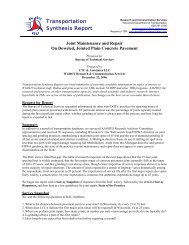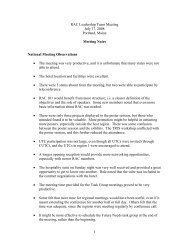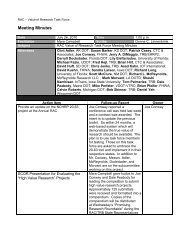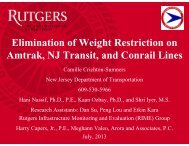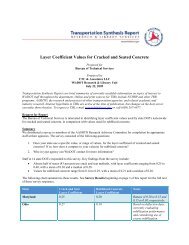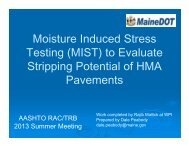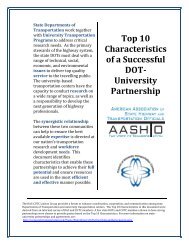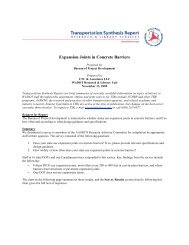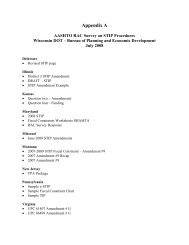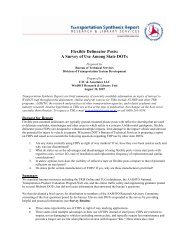PART IV: Summary of Comments - SCOR/RAC
PART IV: Summary of Comments - SCOR/RAC
PART IV: Summary of Comments - SCOR/RAC
You also want an ePaper? Increase the reach of your titles
YUMPU automatically turns print PDFs into web optimized ePapers that Google loves.
<strong>PART</strong> <strong>IV</strong>: <strong>Summary</strong> <strong>of</strong> <strong>Comments</strong>17-May-10Reviewer <strong>Comments</strong> Distribution <strong>of</strong> Ratings■ There has been much research on this topic and it is not clear that this would be a good return on investment.■ Combine with G-22■ Combine with G-22■ There is a need to document existing methods and to develop new strategies for accommodating pedestrians at trafficsignals and signalized arterials. Transportation agencies need better guidelines to design and operate urban transportationsystems. This problem statement ranks medium in comparison to the others reviewed.■ Not much benefit for MS.Item #90:G-25Enhancing Critical Lane Volume Analysis byIncorporating Intersection Geometry(17)(46)NR 0 1 2 3 4 5<strong>SCOR</strong> 5 5 3 3 1<strong>RAC</strong> 3 7 15 17 6 1Standing Committee on Research■ This project improves upon a methodology that is not in wide use in many states. This method has some limitedapplications compared to the Highway Capacity Manual.■ [Rating: 4] This project is for a practical extension <strong>of</strong> the CLV signal timing technique for turn bays, queues, andunconventional intersections. The goal is to provide a simpler quicker alternative to Highway Capacity Manual Analysis.The use <strong>of</strong> service volume tables rather then critical lane analysis with the HCM does not provide a practical alternativegiven the context <strong>of</strong> the proposal approach. The area is important and merits a medium high priority.Research Advisory Committee■ Volume capacity at intersections is a significant issue in OK.■ The proposal appears to <strong>of</strong>fer project development savings and operational efficiencies, although the operational benefitsare understated. Research approach lacks detail.■ It's not clearthat the current approach, given the use to which it is put, is terribly deficient■ SHA Submission (Operations)Item #91:G-17What Information Should Be Provided to PedestriansRegarding Pedestrian-Activated Beacons?(17)(46)NR 0 1 2 3 4 5<strong>SCOR</strong> 6 3 5 3<strong>RAC</strong> 1 3 11 6 15 13Standing Committee on Research■ While project costs seem relatively low, the benefits <strong>of</strong> such research do not appear to be great. While the researchobjective is sound, if prioritizing pedestrian projects, this effort should be on the lower end <strong>of</strong> the scale. This should bean MUTCD research project.■ Suggest that Problem Statements G-11, G-17, G-24, G-33 and G-36 be combined.■ The question is very important but agree with Panel on consistency -- research might be expanded to include all types <strong>of</strong>pedestian crossings. (additional Richard Moeur comment): Agree that new signs may not be understood & needhuman factors testing. (example: the R10-22 in the MUTCD went thru 6 iterations before it was well-understood)■ [Rating: 3] A good project but relatively low priority compared to others. The project need to be refocused on what is thepedestrian's interpretation <strong>of</strong> the feedback message--do they fully appreciate and understand the fact that it is not aprotected crossing? In addition, what effect, if any, do the beacons have on driver behavior?Research Advisory Committee<strong>IV</strong>-66



